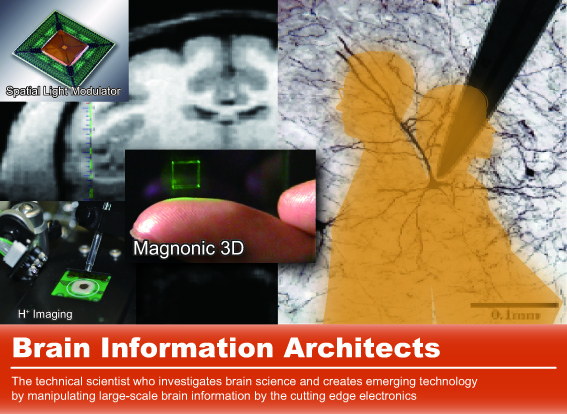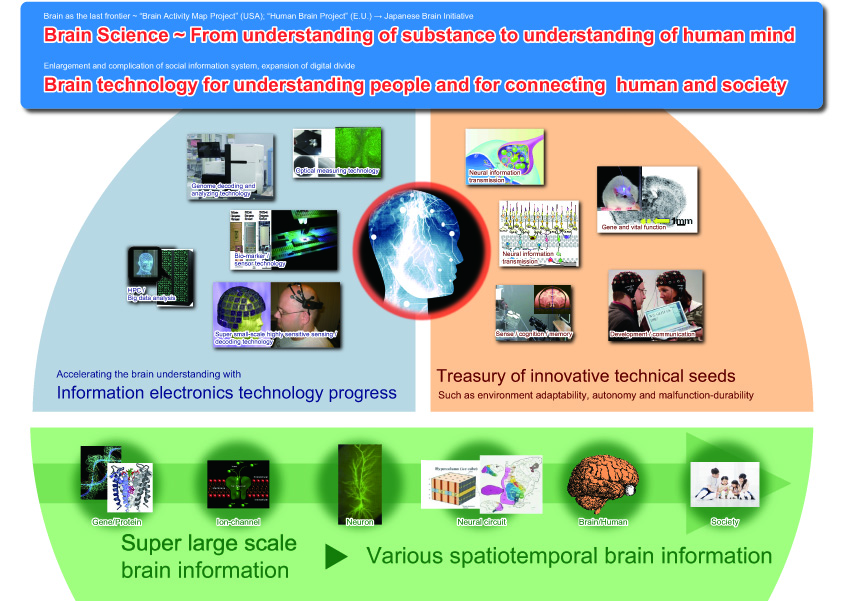Program
About the Brain Information Architect
The “Brain Information Architect” is an engineer with problem-solving skills developed from studying the brain and applying the sensing devices and simulation techniques to the wide variety of spatial and time scales relevant to brain information. The scope of subjects these studies apply to range from the genome to the individual and society, and include the development of new principles and new electronic devices and information processing systems. The program’s objective is to train the brain information architects who will become globally active leaders in the industry, academia, and government.

The Background of the Brain Information Architect
The development of electronic information technology has resulted in significant changes in modern society. In particular, information networking has become essential to society’s core technology as a massive information source, connecting machines to machines and individuals to individuals.
However, the trend of computerization has caused greater complexity in society and the size of information to be processed has grown significantly. In addition, the environmental impact of such technologies has increased, and the “digital divide” has expanded.
To tackle these issues, it is necessary to reconsider the various technologies that support an information-oriented society from the perspective of information usage. In other words, we need to have a paradigm shift from looking at information technology as something only for high-speed transmission and storage, into “information technology grounded in scientific understanding of human or social cognition, understanding, decision-making, and action-taking.”
This is not only a new challenge for the fields of science and technology but also an extremely important project for strengthening Japanese science and technology to compete globally from the mid-to-long-term point of view.

Our objective to shift the paradigm in information electronics cannot be achieved by the mere extension of conventional information science and technology. Therefore, we consider it essential to create an innovative information technology structure based on what has been learned about the brain’s functions and systems, in the way that we explore the brain as a source of a large amount of information on various levels, from the microscopic (genome) to the macro-social (organization).
In the EU, for example, a national project called the “Human Brain Project (HBP)” has kicked off with a huge budget (1.2 billion Euros over 10 years). At the same time, the Brain Activity Map Project is being launched in the United States as well. The potential gains from these investments can be learned from the Human Genome Project, where 3.8 billion dollars of investment generated 800 billion dollars of return. Brain science, post-genome, is expected to be an innovative driving force to create new industries and will be promoted globally as a guideline for restructuring social value systems based on human understanding.
Our university has been developing “Tailor-Made Baton-Zone Education” for students in the second half of the doctoral course since 2009. The aim is to address the issues that arise in interdisciplinary study and the collaboration of academia and industry. As we consulted with top executives from leading corporations, we began to realize the importance of reconsidering the various technologies that support an information-oriented society from the perspective of information application.
To solve these issues, we concluded that it is essential to promote brain science research by using information technology, to develop human resources, who will accelerate progress in brain science technology, and encourage related industries.
We have recognized the urgency of cooperating with domestic and foreign industries, as well as research institutes to train new researchers to become “Brain Information Architects” – a technological researcher who can further develop brain science using advanced information technology, and who can create innovative technologies from studying the function and operation of the brain.